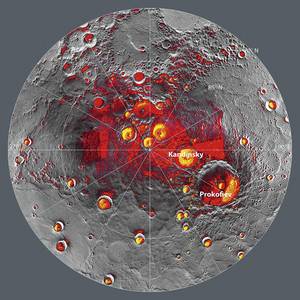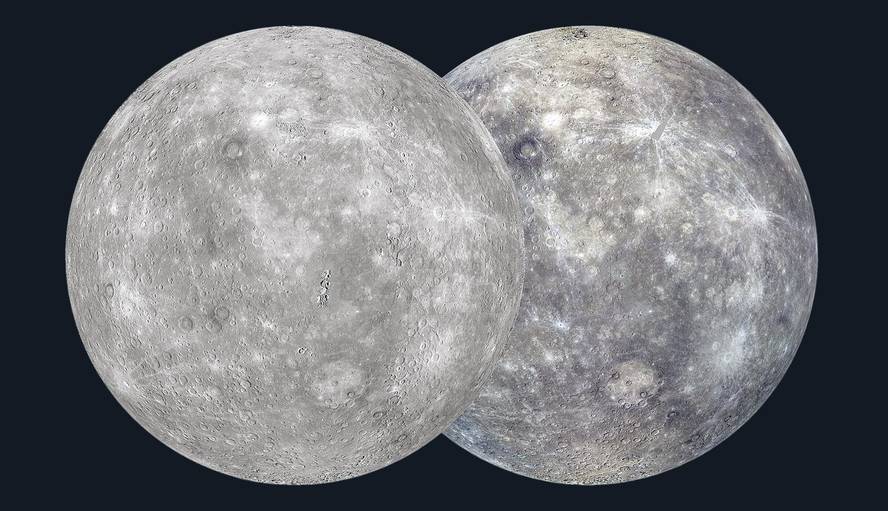Mercury, an unexpected planet
When it passed with Mercury in January 2008, the Messenger probe was moving too fast. He could not enter orbit around the planet. So he made an approximation that astronomers call flyby. He obtained photographs of the planet and, above all, the attraction of gravity helped him to slow down a little. But it was still too fast, it had to pass another two times without stopping near the planet and finally, on March 18, 2011, it entered the orbit of Mercury.
One of the problems to investigate Mercury is speed. To get closer to the planet, the probes move too fast as Messenger. The planet itself also presents a very fast orbit, faster than any other planet in the Solar System, due to its proximity to the Sun. And the rotation of the planet is very slow. "Because the Sun itself slows the rotation of Mercury. And it's hard for him to turn on himself," says UPV astronomer Jesús Arregi and a member of the Planetary Sciences Group.

Mercury's day, the time it takes to take a full turn around itself, is 59 terrestrial days. Turn very slowly. For this reason, the Italian astronomer Giovanni Schiaparelli said that Mercury always had the same difference oriented towards the Sun. In the 1960s, thanks to radar, astronomers discovered that all sides of the planet remained looking at the Sun before or after.
This is very important for current researchers, as the conditions are very different, whether they are in the dark from the Sun. "59 days after the investigation ensure that all parts of Mercury have spent their day of light and their night," says Arregi. "There may be incidents in the difference between night and day. This type of issue should be analyzed before publishing anything, while the data could be deformed. That's why it leaves a little time for the cycle to be fulfilled." Messenger entered orbit in March 2011 and the first results of the research carried out with the data collected were disseminated in October.
Information in photos
There was a lot of hope with the photos. Before Messenger, in 1974 and 1975, it was the Mariner 10 probe near Mercury, but it does not enter orbit. He made three flybys and in all three was lit the same side of Mercury. The probe did many photos, but only 45% of the planet's surface could. Messenger photos have also shown the part I had not seen before.
"These are very high-definition photos," says Arregi. "The black and white exits give us a resolution of 250 meters. That is, you see everything that is bigger. Below still not. Color resolution is one kilometer. And then, in the special photos, which have been made to study special details, you get a resolution of ten meters. Therefore, photographs are obtained in much detail, which has made so many discoveries possible."
Thanks to the resolution of the photos also see craters that have not been seen before. According to experts, the smallest craters on Mercury's surface are the size of a cup and the largest of several hundred kilometers in diameter. And they have very useful information for astronomers. Lacking the planet atmosphere, the craters generated on the planet have degraded little. Non-eroded surface. The stones contain remains of everything that has happened. And craters help interpret this particular scripture.
Astronomers have known geological activity thanks to images of craters. The crater produced by the impact of a body must be circular or elliptical. But the photos sent by Messenger show some deformed craters, the result of geological movements.
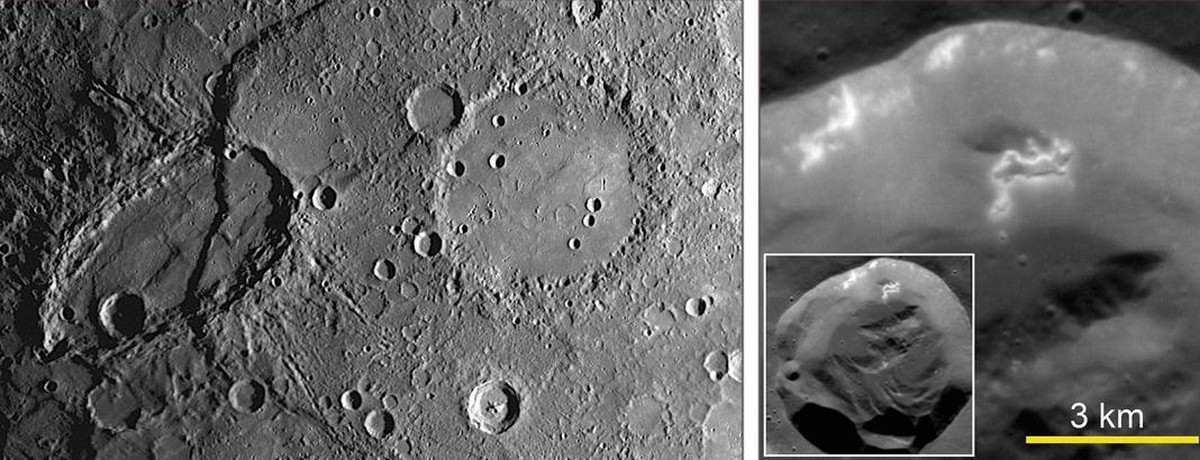
It was a surprise. Astronomers did not expect Mercury to have a geological activity, because they expected it to be like the Moon. "The Moon is considered a dead star. Its surface does not vary at all. But it seems that Mercury's is gradually changing," explains Arregi. On the other hand, "in the case of the Moon we have lava seas that are plains. And in Mercury it was not known. Now we know that there is also there, especially in Iparralde. They are very wide, but their composition is not the same as that of the Moon. In moles, the concentration of silicates is higher than in those of Mercury. In Mercury, aluminum, sodium and magnesium silicates are in smaller amounts, meaning that the origins of the Moon and Mercury were different."
Craters and lava plains are not the only structures seen in the photographs. You can see other types of unique structures. "These structures have been called hondoned and we see them bright in the photos and with a bluish color," says Arregi. They are small structures, but many are created, joining together forming irregularly shaped structures. From a few meters to a couple of kilometers deep.
Experts believe that these structures are not a mere consequence of the activity of yesteryear, but are occurring today, which would mean that the material is evaporating in these areas. "It wasn't expected," says Arregi. "Since Mercury has to withstand a very high temperature, very close to the Sun, we thought it would not have volatile material, but it does. Depressions are caused by evaporation of this material."
Like a giant kite

Unlike the moon, the evaporated material in Mercury produces gas. Oxygen, hydrogen, helium, sodium, potassium and other elements are "flying" around the planet, but in very small amounts. "It is not properly an atmosphere. Mercury has no atmosphere," says Arregi. The planet does not have enough gravity to withstand this gas.
In addition, the Sun also brings a lot. "The sun produces solar wind. It emits particles in large quantities and at high speed, mainly electrons and protons, which are being bombarded continuously. Precisely when they touch on the surface, they extract from the surface other atoms, which are responsible for a certain atmosphere of Mercury. The particles extracted from the surface by the solar wind form what we call the exosphere. It is a very fine atmosphere, composed of very special particles."
The word atmosphere is not the most suitable for describing the presence of these particles: the particles evaporate from the surface and are dragged by the solar wind continuously. In this sense, Mercury behaves like a comet. "In the case of comets, the tail is produced mainly by the solar wind, and in Mercury it is also the way of the creation of the exosphere," says Arregi.
The heart of a planet
Mercury is not a comet, it is a planet, but it is a special planet. In a general classification, it is part of the group of four small planets near the Sun, along with Artizar, Earth and Mars. It is clear that it is not a gas giant like Jupiter or Saturn. But within the group of "stony" planets it is also special, and the cause is in the heart of Mercury.
In the group of stone planets there are no standards, but the overall model would be a metallic core surrounded by a layer of rock. The only exception to this basic scheme is Venus, since it has no metallic core. But Mercury is even more rare, almost the opposite case: in proportion it has a giant nucleus.
Mars has a small solid iron core. The Earth, at the core, has a solid, liquid iron that occupies about half the radius of the planet. And Mercury also has a solid, liquid iron core that occupies almost three-quarters of the planet's radius. Therefore, Mercury is very dense.
Because of its small size, it does not have the gravity of Earth or Venus to compact materials as much as on those planets and yet it is denser than Venus and only slightly lighter than Earth. This is due to its proportion of iron. In fact, astronomers have often mentioned that Mercury looks like the core of a planet that has almost completely lost the outer layer of stone.
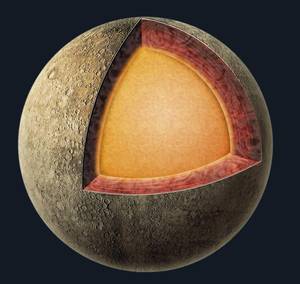
No one knows why. And one of the objectives of the Messenger probe is to collect data to clarify the origin of the giant core of Mercury. But at the moment, there is no good news in this study.
"If things were mysterious before, now they are more mysterious," explains Arregi. "There were two theories before that Mercury was so dense. The first is a clash of another star that would take your skin. Since the heavier elements always remain inside, that core that remained would be Mercury. The second theory is that the heat of the Sun caused the evaporation of the skin and therefore the light and volatile elements disappeared. But Messenger has discovered that Mercury has volatile elements, much more than Venus or Earth and Moon."
The chemical composition of volatile elements corresponds to the composition of meteorites called condrites, that is, it has metal components and non-oxidized metals, so it is possible that instead of being a planet that has lost surface, Mercury has been created by an unknown process from meteorites such as condrites. "Therefore, we cannot accept the above theories because we have the following elements. This can be an indication of how Mercury was born. And, in addition to clarifying the genesis, we must clarify a little how the raw material of that generation was. But we still don't have enough data and there is no clear hypothesis."
No magnetic south pole
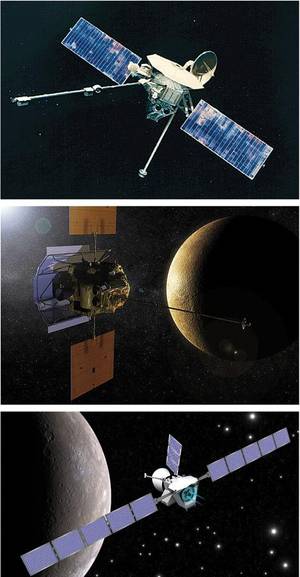
Another great scare has been the magnetic field, both in Messenger research and before. In the 1970s the Mariner 10 probe discovered that it has a magnetic field and was surprising. Also at that time astronomers considered that Mercury is like the Moon and that the Earth satellite has no magnetic field. A compass does not work on the Moon. But in Mercury yes. The needle of a compass would not be oriented as quickly as on Earth, since the Mercury area is 150 times weaker, but eventually would end up pointing north.
But the magnetic supports did not end the discovery of Mariner 10. Messenger measurements have also been spectacular. "The magnetic field has a very curious peculiarity: it is not centered," explains Arregi. "That is, the equator of the magnetic field does not coincide with the equator of the planet, as occurs on Earth. The magnetic field is shifted north, that is, it is shifted upwards. In the north, the intensity is 3.5 times higher than in the south. This has consequences, for example, on protecting against the solar wind. The North is more protected than the South, against all particles coming from the Sun. This influences both the atmospheric formation of Mercury and the degradation of the skin, so to speak."
Astronomers still do not understand why the magnetic field is asymmetric and do not understand how Mercury's giant nucleus emerged. Nor why it causes volcanic activity. To carry out these studies, ESA and JAXA, European and Japanese Space Agencies, will send a new probe to Mercury, Bepicolombo. It will be launched in 2015 and will enter orbit around Mercury years later. New efforts will be needed as Mercury research is a major challenge. Sometimes, obtaining data, rather than providing answers, brings more questions.
